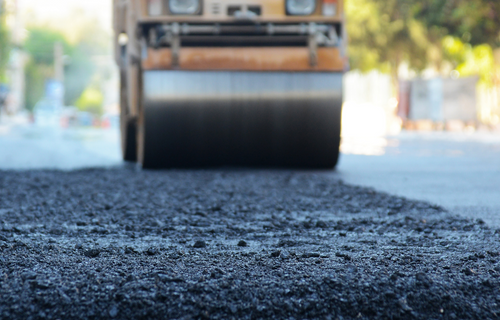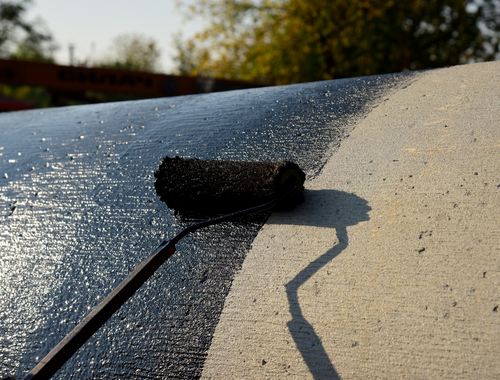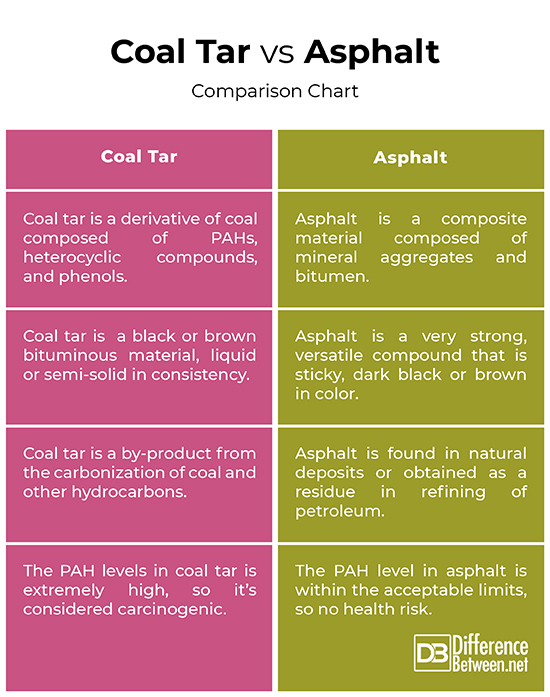Difference Between Coal Tar and Asphalt
Since the Industrial revolution, bituminous materials are very much preferred in building and road constructions. These materials are composed of highly molecular weight hydrocarbons, and soluble in carbon disulfide. There are many grades of bitumen, each of which exhibits different characteristics. The performance of each grade of bitumen depends largely on its physical properties like plasticity, elasticity and hardening at various conditions. On the basis of such properties several different types of additives are used along with bitumen for construction. Two common bituminous materials being used are tar and asphalt.

Asphalt
Asphalt, also known as bitumen, is a sticky, dark viscous substance found in natural deposits or obtained as a residue in refining of petroleum and that consists mainly of hydrocarbons. It is basically a composite material composed of mineral aggregates and bitumen with varying degrees of viscosity ranging from viscous liquid to glassy solid. You probably drive on asphalt roadways almost every day. After all, most of the roadways in the United States are surfaced with asphalt. A typical asphalt mix is made up of almost 95 percent aggregates, meaning stone, sand and reclaimed products. The other 5 percent of the mix is the liquid asphalt glue. It is refined from the heavy components of crude oil and does not come from tar.

Coal Tar
Coal tar, as the name suggests, is a derivative of coal. It is a byproduct of the production of coke and coal gas. It is a highly viscous black color liquid formed as a by-product from the carbonization of coal and other hydrocarbons. Tar has low bitumen content and is obtained from the destructive distillation of organic substances such as coal, wood, or other bituminous materials. American Society for Testing and Materials (ASTM) defines coal tar as a black or brown bituminous material, liquid or semi-solid in consistency in which bitumen is used predominantly, and which yields substantial quantities of pitch when distilled. Coal tar is the most commonly used form of tar predominantly used in the paving industry. Some of the major constituents of coal tar are PAHs, heterocyclic compounds, and phenols.
Difference between Coal Tar and Asphalt
Composition
– Asphalt and coal tar are very different chemical products with different composition. Asphalt is a composite material composed of mineral aggregates and bitumen with varying degrees of viscosity. It consists of compounds of hydrogen and carbon with nitrogen, oxygen and sulfur is minor quantities. Coal tar, on the other hand, is a derivative of coal. Some of the major constituents of coal tar are PAHs, heterocyclic compounds, and phenols. The composition may vary across lots and manufacturers.
Color/ State
– Asphalt, also known as bitumen, is a very strong, versatile chemical compound that is sticky, dark black or brown in color with varying degrees of viscosity ranging from viscous liquid to glassy solid. Coal tar, on the other hand, is thick very dark black liquid which consists of hydrocarbons. ASTM defines coal tar as a black or brown bituminous material, liquid or semi-solid in consistency in which bitumen is used predominantly.
Source
– Both coal tar and asphalt are naturally occurring compounds. Asphalt is found in natural deposits or obtained as a residue in refining of petroleum and that consists mainly of hydrocarbons. It binds crushed stone and aggregates into firm, tough surfaces for construction of roads, streets and airport runways. Coal tar is a by-product from the carbonization of coal and other hydrocarbons. It has low bitumen content and is obtained from the destructive distillation of organic substances such as coal, wood, or other bituminous materials.
Hazard
– Although coal tar exhibits excellent water-proofing and water resistant property, it is considered carcinogenic, meaning it has the potential to cause cancer. There are many forms of PAHs which exhibit the properties of carcinogenic material and level of such PAHs in coal tar is extremely high. The PAH level in other bituminous materials including asphalt is within the acceptable limits. So, direct exposure to coal tar can be hazardous to human health, while exposure to asphalt does not pose any significant health risks.
Coal Tar vs. Asphalt: Comparison Chart

Summary
Both asphalt and coal tar are very different chemical compounds. Although coal tar exhibits excellent water-proofing and water resistant properties, it is considered carcinogenic because the PAH levels in coal tar is extremely high and direct exposure to tar can be hazardous to human health. Asphalt, on the other hand, is found in natural deposits or obtained as a residue in refining of petroleum, and contains PAH within acceptable limits. Carbon content is low in asphalt but high in coal tar. Asphalt takes less time to settle, while coal tar takes more time.
Is coal tar the same as asphalt?
Coal tar is obtained from the destructive distillation of organic substances such as coal, wood, or other bituminous materials. Asphalt is found in natural deposits or obtained as a residue in refining of petroleum.
What is the difference between coal and tar?
Coal is a brownish-black or black color sedimentary rock composed predominantly of carbon and hydrocarbons, and is formed from of decomposition of plant life. Tar is an oily, viscous and deep black compound consists of hydrocarbons, and is formed as a by-product from the carbonization of coal and other hydrocarbons.
What is coal tar asphalt?
Coal tar is a by-product of bituminous coal that contains a tar-like substance called bitumen, or asphalt.
What is the difference between asphalt tar and pitch?
These are hydrocarbons obtained from the partial distillation of crude petroleum. Because of their viscosity and binding properties, they are used as great waterproofing and sealing agents.
- Difference Between Caucus and Primary - June 18, 2024
- Difference Between PPO and POS - May 30, 2024
- Difference Between RFID and NFC - May 28, 2024
Search DifferenceBetween.net :
Leave a Response
References :
[0]Lavin, Patrick. Asphalt Pavements: A Practical Guide to Design, Production and Maintenance for Engineers and Architects. Florida, United States: CRC Press, 2003. Print
[1]Misra, Anil Kumar. Building Materials and Construction. New Delhi, India: S. Chand Publishing, 2018. Print
[2]Kubal, Michael T. Construction Waterproofing Handbook (Second Edition). NYC, United States: McGraw Hill Professional, 2008. Print
